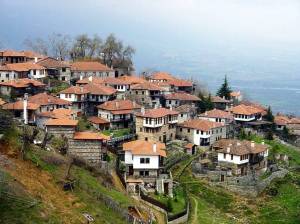When did human creations stop being natural? We look at a tower block, a subdivision or a shopping mall parking lot and see the worst of industrial civilization translated into form. We tolerate them as necessary to achieve the material wealth of our civilization. Those human settlements that are still natural we grant special protections through UNESCO and historical preservation laws. We do not have a law that promotes the creation of new historic settlements because we are not quite sure how they are made.
I believe that our mistake is not in the things we make, that there is nothing unnatural about a shopping mall parking lot from a design point of view. What makes the shopping mall parking lots we build so unnatural are errors in configuration of the design elements. To understand this, one must understand the difference between design and configuration.
The form of a tree is an ideal example to illustrate the difference between the two concepts. Any particular species of tree will have a design that is essentially the same from one tree to the next. The design elements in the tree are all the named parts: trunk, branch, leaf, root, bark, and so on. These parts are organized into hierarchical relationships with the whole tree and with each other. We will always find the roots related with the trunk in the same way. This relationship is a design solution that achieves a specific result. However, the position of any of the parts is not fixed. In the DNA of the tree are rules that instruct cells to adapt themselves to the larger context the tree finds itself in. The different design solutions that result from this cellular action will therefore adopt a position that reflects the particulars of time and place, ensuring that the tree's form is perfectly adapted to its environment. This is why it makes no sense to create a description of the forms of a leaf in order to make another leaf - that form is relevant only to this particular leaf, and another leaf, although it would have the same overall design of parts, will take a completely different configuration.
If you're having trouble seeing this, imagine the following scenario: we take the DNA of a tree and clone it 100 times. Then we lay out a grid 10 trees by 10 trees and watch them grow. What would happen would be that every tree would come out a different way, since the earth around them would be structured differently, the wind patterns would be different, the shade and the moisture would be different. The trees would each have the chaotic, random shape that we know trees to have, yet would all be perfectly symmetrical with one another without being identical. Each clone would adopt a unique configuration of the same design.
When we look at a traditional village, we find that the same house design is repeated time and time again, but configured in such a way that it is differently adapted than the other houses. The reiteration of an often very simple design is all that it takes to create a natural landscape, so long as each house is configured to adapt to its place, and the design elements of the house are themselves configured to adapt to these adaptations.
Even today this kind of natural adaptation takes place in modern settlements where planning regulation allows it, or fails at forbidding it.
This is the skyline of Monaco, which by necessity of the small size of the city had to be built piecemeal but yet is still made with an entirely modern building stock. The piecemeal process allowed each building to be configured to its site and thus, despite the fact that the buildings' design is very basic modern architecture, the whole landscape looks natural. It would be even more natural were the architectural elements also adapted.
This the Rocinha favela of Rio de Janeiro. Here the building design is as bare as could be made, the houses being built by poor residents with little capital to invest. But the resulting configurations adapt perfectly to the shape of the hill and the other buildings, and the overall look of the place is that of a human jungle. (If you have the chance to see this summer's The Incredible Hulk, the movie makes this point by fading from an overhead shot of Rocinha to that of a tropical jungle, subtlety be damned.) The buildings in Rocinha are just as natural as the trees.
How does that translate back into our shopping mall parking lot? It means that although the relationship between the parts, for example the lanes, the spaces and the paint that demarcates them, must be defined, the length of the spaces or the thickness of the demarcations do not have to be identical from one element to another. The chaos of nature requires that they be slightly different from one to the next, and that means that the people who make them must be able to make decisions while they are building. Simply copying an AutoCAD drawing is unnatural. The design must be translated into a language that instructs the builders to make configuration choices while constructing the defined forms. This kind of language is how builders have made traditional towns and how DNA makes organisms.
Separating design from configuration also allows us to make a second attempt at city planning. The plans of modernists all had fixed configurations, and their failure to adapt to their context meant the failure of urban planning. The conflict between design and configuration planning dates back even further, to the 19th century plans for Barcelona and Paris. In Barcelona, Cerda planned a grid of square blocks through which he ran grand diagonal avenues. Those were only two design elements in a very strict configuration that was made possible only by the enormous economic pressure to expand Barcelona. In Paris, Haussmann did not have the luxury of expanding the city with blocks, he had to upgrade a city of blocks that already existed with a new design element, the grand avenue. He deliberately left the configuration of his avenues open until they were completed, and placed them where he met the least resistance. Their effect on Paris is even today essential to life, and they could not have been realized unless their configuration was left adaptive.
What would a natural urban design look like? It must first be a definition of parts that must be related to each other in order to create urbanity. Describe the relationship between the avenue and the streets, the streets and the alleys, describe the relationship between the avenue and the pavement, the pedestrian crosswalks and the shade trees. Describe the relationships with the buildings without delimiting their size and shape. The city builders will then decide in what configuration these elements need to be to fit their context, and the resulting built form of the city plan will be perfectly natural as well as fully planned.
Classicism describes itself as the imitation of nature. Complexity, on the other hand, does not imitate. It is nature, applied to different problems. To create the urban design of our time requires not adopting a certain style or program, but ensuring that any style or program can be adapted to a particular context. It only requires us to use different tools than what we have become accustomed to.
Further reading:




Interesting observations, and in general I agree. However, I would add that another powerful part of this film is the dystopian idea that in a "dis-aggregated" world of suburban limbo, violent death is inevitable, and often emerges out of sheer boredom.